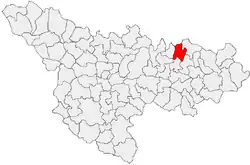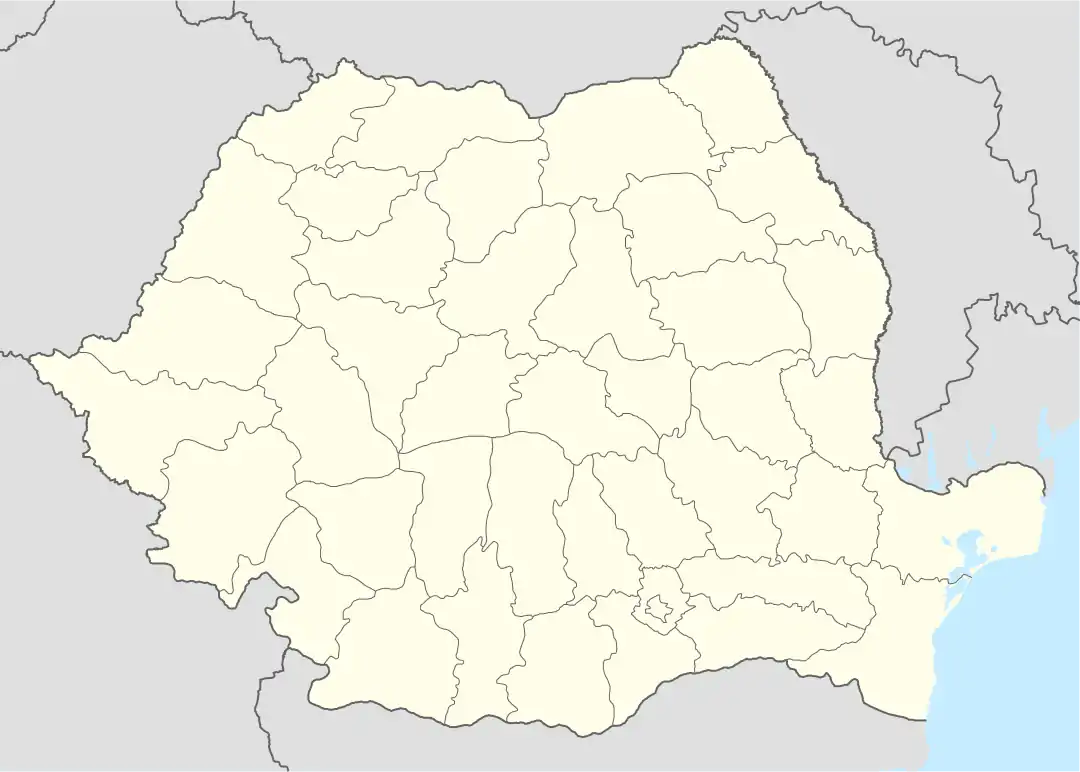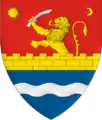Bara, Timiș
Bara (Hungarian: Barafalva) is a commune in Timiș County, Romania. It is composed of five villages: Bara, Dobrești (Hungarian: Dobrosd), Lăpușnic (Hungarian: Bégalaposnok), Rădmănești (Hungarian: Radmanóc) and Spata (Hungarian: Bégapata). Bara is located in the northeast of Timiș County, in a hilly area, 70 km from Timișoara and 30 km from Lugoj.
Bara | |
|---|---|
.JPG.webp) St. George Orthodox church in Bara | |
 Location in Timiș County | |
 Bara Location in Romania | |
| Coordinates: 45°54′24″N 21°54′1″E | |
| Country | Romania |
| County | Timiș |
| First recorded mention | 1367 |
| Government | |
| • Mayor | Daniel Ursu (PSD) |
| Area | |
| • Total | 70.4 km2 (27.2 sq mi) |
| Population (2018)[2] | |
| • Total | 303 |
| • Density | 4.3/km2 (11/sq mi) |
| Time zone | UTC+2 (EET) |
| • Summer (DST) | UTC+3 (EEST) |
| Postal code | 307020–307024 |
| SIRUTA code | 155662 |
| Website | www |
History
The first recorded mention of Bara dates from 1367.[3] The name Bara is of Slavic origin and, in medieval documents, is associated with the description "terra acquosa", meaning a marshy land. In 1440 Bara is taken from the prefect of Timiș by King Vladislav I and given to the Șoimoș Fortress.[4] By 1477 it was the property of the prefect of Pozsony, Miklós Bánffy.[4] Under the Turks it was destroyed and re-established in 1690–1700. In 1879 Bara was bought by Pavel Teodorescu and Constantin Florea.[4] The village was Romanian and remained mostly Romanian during the Austro-Hungarian rule.[4]
All the villages in the commune were massively depopulated after World War II. Spata, for instance, became a ghost village in 1997 with the death of the last native. However, the settlement was repopulated by several families of Transylvanian shepherds.[4]
Demographics
Bara had a population of 388 inhabitants at the 2011 census, up 3% from the 2002 census. Most inhabitants are Romanians (97.94%). For 1.8% of the population, ethnicity is unknown.[5] By religion, most inhabitants are Orthodox (97.42%). For 1.8% of the population, religious affiliation is unknown.[6]
| Census[7] | Ethnic composition | |||
|---|---|---|---|---|
| Year | Population | Romanians | Hungarians | Germans |
| 1880 | 2,980 | 2,890 | 15 | 52 |
| 1890 | 2,857 | 2,809 | 36 | 11 |
| 1900 | 3,378 | 3,283 | 56 | 36 |
| 1910 | 3,381 | 3,289 | 37 | 37 |
| 1920 | 3,190 | 3,164 | 8 | 9 |
| 1930 | 3,105 | 3,066 | 9 | 25 |
| 1941 | 2,927 | 2,904 | 6 | 15 |
| 1956 | 2,633 | 2,620 | 8 | – |
| 1966 | 1,885 | 1,881 | 1 | 1 |
| 1977 | 816 | 811 | – | – |
| 1992 | 427 | 417 | 9 | – |
| 2002[8] | 378 | 367 | 8 | – |
| 2011 | 388 | 380 | – | – |
Notable people
- Daniel Ciobotea (b. 1951), Patriarch of the Romanian Orthodox Church (2007–present)
References
| Wikimedia Commons has media related to Bara, Timiș. |
- "Primăria Bara". Ghidul Primăriilor.
- "Populația României la 1 ianuarie 2018 (date definitive)". Institutul Național de Statistică.
- Szabó, M. Attila (2003). Erdély, Bánság és Partium történeti és közigazgatási helységnévtára. Miercurea Ciuc: Pro-Print Kiadó.
- "Fișa Primăriei comunei Bara". Consiliul Județean Timiș.
- "Tab8. Populația stabilă după etnie – județe, municipii, orașe, comune". Institutul Național de Statistică.
- "Tab13. Populația stabilă după religie – județe, municipii, orașe, comune". Institutul Național de Statistică.
- Varga, E. Árpád. "Temes megye településeinek etnikai (anyanyelvi/nemzetiségi) adatai 1880-1992" (PDF).
- "Bara / Barafalva". Structura etno-demografică a României. Centrul de Resurse pentru Diversitate Etnoculturală.
